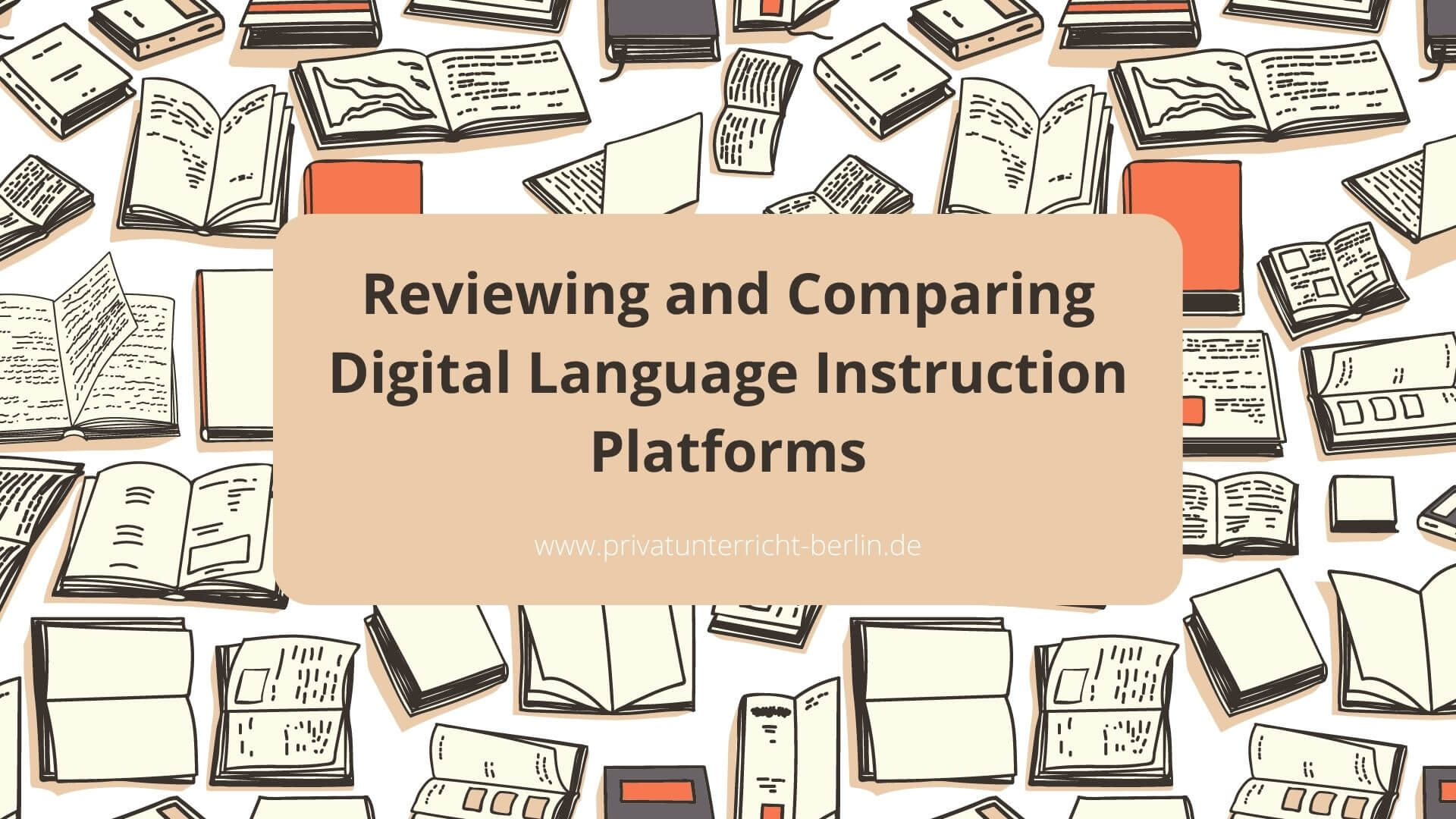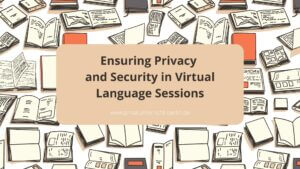Your Language Journey, Your Way: Start with a Private Tutor

Reviewing And Comparing Digital Language Instruction Platforms
Hey there, language learners. Have you ever needed help in the sea of digital language instruction platforms? With so many options available, choosing one that fits your needs and learning style can be overwhelming.
Fear not, as we are here to help guide you through this process by reviewing and comparing some of the market’s top digital language instruction platforms.
In today’s fast-paced world, where technology is advancing at an unprecedented rate, online language learning has become more accessible than ever before. However, with this increased accessibility comes many choices for digital language instruction platforms. Each platform offers unique features and approaches to teaching languages, making it challenging to decide which one will work best for you.
That’s why we’ve taken up the task of evaluating these platforms based on various parameters such as user experience, content quality, pricing plans, and more. So buckle up and prepare for a comprehensive review of some of the most popular digital language instruction platforms out there!
Table of Contents
User Experience: Navigating And Interacting With Platforms
Imagine learning a new language without leaving your house, at your own pace, and on your schedule. This is the promise of digital language instruction platforms, which allow users to access materials and lessons anytime, anywhere.
But what sets apart one platform from another? This review will examine two key aspects: user experience and content quality.
Regarding user experience, accessibility options are crucial for ensuring learners of all abilities can easily navigate and interact with the platform. These options should be integrated seamlessly into the design rather than feeling like an afterthought.
Additionally, gamification elements such as badges or rewards for completing tasks can keep learners motivated and engaged throughout their language journey.
With these factors in mind, let’s dive deeper into how different platforms approach user experience.
Content Quality: Assessing The Effectiveness Of Instruction
Now that we have explored the user experience of digital language instruction platforms let’s shift our focus to content quality. After all, what good is a platform if it doesn’t effectively teach learners?
When assessing the effectiveness of instruction, one key factor to consider is real-life application. Real-life application refers to how well the platform prepares learners for using their newly acquired language skills in actual situations. Does the venue provide opportunities for learners to practice speaking and writing in realistic scenarios? Are there cultural lessons or activities that help learners understand what they may encounter when communicating with native speakers? By prioritizing real-life applications, platforms can increase learner engagement and ensure that their efforts lead to tangible results beyond just passing a test.
As we delve deeper into evaluating the cost and value of platforms, it’s important to remember that simply having a high price tag does not necessarily equate to higher quality or effectiveness. Similarly, opting for the cheapest option may not be the best decision either.
It’s crucial to assess pricing plans based on factors such as available features, customer support availability, and overall reputation within the industry. Remember any additional costs associated with purchasing textbooks or materials separately from the platform. Ultimately, finding a balance between affordability and quality should be at the forefront of any decision-making process when selecting a digital language instruction platform.
Pricing Plans: Evaluating The Cost And Value Of Platforms
Regarding pricing plans for digital language instruction platforms, various options are available. Some venues offer tiered plans based on the number of users or features needed, while others have a flat rate for all users. It’s vital to evaluate both the cost and value of these plans.
Customization options can significantly impact the overall value of a platform. The ability to tailor lessons and activities to specific learning goals and styles can make a significant difference in student engagement and comprehension. Additionally, customer support is an essential aspect to consider when evaluating pricing plans. A platform with responsive and knowledgeable support teams can save time and frustration in troubleshooting technical issues or navigating unfamiliar tools.
To help evoke emotion in our audience, we’ve created nested bullet points below that illustrate how customization options and customer support can enhance the learning experience:
- Customization Options:
- Students feel more engaged when content is tailored to their interests
- Teachers have greater flexibility in adapting materials to meet individual needs
- Customer Support:
- Prompt resolution of technical issues reduces stress for students and teachers alike.
- Accessible support staff provides peace of mind for educators new to online teaching tools.
Overall, an effective online learning platform can enhance the teaching and learning experience, providing a more personalized and convenient approach to education.
Unique Features: Analyzing Differentiation And Innovation
Now that we have evaluated the cost and value of each platform, let’s dive into what truly sets them apart – their unique features.
One significant aspect to consider when comparing digital language instruction platforms is adaptive technology. This means the platform can adjust to meet the needs and abilities of individual learners. Some media use artificial intelligence algorithms to create personalized learning paths for each student based on their progress. In contrast, others allow teachers to manually customize lessons and activities for their students.
Another essential feature of digital language instruction platforms is gamification techniques. These elements, such as leaderboards, badges, or rewards, make learning more engaging and motivating. Media may also incorporate game-like activities or simulations to help reinforce language skills in a fun way. While some learners may find these features distracting or unnecessary, others thrive on this type of interactive approach to learning. Ultimately, it comes down to personal preference and what works best for each learner’s style and motivation levels.
As we continue our evaluation process, it’s important to weigh both the benefits and drawbacks of each platform before making a final decision. In the next section, we will explore the pros and cons of each platform in greater detail so you can make an informed choice about which will be most effective for your language learning goals.
Pros And Cons: Weighing The Benefits And Drawbacks Of Each Platform
When choosing a digital language instruction platform, one of the critical factors that every user should consider is the learning outcomes. This metric measures how effective each platform is in helping learners achieve their language goals. Some venues offer more interactive and engaging content, while others provide personalized feedback and assessment tools to measure progress.
Another crucial aspect to remember is the technical requirements for each platform. Compatibility with different operating systems, devices, and hardware can vary from provider to provider. It’s essential to assess which method will work best for your needs and ensure access to any necessary equipment or software before committing to a specific option.
By weighing both the benefits and drawbacks of each platform regarding these two aspects, users can decide which product fits their needs best.
Frequently Asked Questions
Do The Platforms Offer Any Personalized Learning Options?
As language learners, we all have unique strengths and weaknesses when absorbing new concepts. That’s why digital language instruction platforms must offer personalized learning options that cater to individual needs.
One of the most effective ways these platforms achieve this is through adaptive learning technology. By analyzing a student’s performance in real time, these programs can adjust the difficulty level of exercises and quizzes accordingly, providing an optimal challenge without overwhelming or underwhelming users.
Individualized instruction goes beyond just setting the right level; it also means creating customized lesson plans based on student’s goals, interests, and proficiency levels. A good platform will consider factors like preferred learning style, time availability, and personality traits.
Ultimately, personalization ensures that users are motivated and challenged enough to stay engaged with their language studies – leading to better outcomes overall.
Are There Any Language Proficiency Tests Available On The Platforms?
When it comes to digital language instruction platforms, one crucial factor to consider is whether they offer any language proficiency tests.
In our pricing comparison and user interface evaluation of various platforms, some offer these tests. These can be incredibly helpful for learners who want to assess their progress and identify areas where they need more practice.
Additionally, the availability of such tests can indicate a platform’s commitment to personalized learning options. If you’re looking for a venue with robust testing capabilities, explore this feature when comparing your options!
How Does The Platforms’ Customer Support Compare?
When choosing a digital language instruction platform, customer support is essential. Even the most user-friendly platforms can encounter technical difficulties or require additional assistance navigating their features.
That’s why 24/7 availability and quick response time are crucial for practical customer support. As a reviewer/comparator of these platforms, I investigate how each delivers on this aspect.
From my experience, some platforms excel with knowledgeable support staff who provide timely responses, while others need to catch up in this area. Therefore, when deciding which platform to use, don’t overlook the importance of good customer support.
Can Users Integrate Their Materials Into The Platforms?
Content customization is a crucial factor for many users when it comes to digital language instruction platforms.
That’s why one of the key questions we explore when reviewing and comparing these platforms is whether or not users can integrate their materials into the system.
Platform compatibility is also an important consideration – how easy is it to upload files from various sources?
Some platforms make this process seamless, while others may require some technical know-how.
Ultimately, the ability to customize content and work with various file types can significantly enhance the learning experience for students and teachers.
Are There Any Social Or Interactive Features On The Platforms?
Are there any social or interactive features on the platforms?
Some digital language instruction platforms offer gamification options to make learning more engaging and fun. These can include point systems, badges, and leaderboards that encourage learners to compete with themselves or others.
Additionally, many platforms have community forums where users can interact with one another, ask questions, share resources, and practice their language skills in a supportive environment. These features not only enhance the learning experience but also help create a sense of belonging among users who may be studying alone or from remote locations.
Conclusion
In conclusion, when it comes to digital language instruction platforms, various options are available that cater to different learning styles and preferences.
It is essential to consider whether the platform offers personalized learning options such as adaptive quizzes or customized lesson plans. Additionally, having access to language proficiency tests can help learners track their progress and identify areas for improvement.
Another crucial factor to take into account is customer support. Platforms with responsive and helpful support teams can make all the difference in providing a seamless learning experience. Furthermore, integrating one’s materials into the platform can enhance the relevance and effectiveness of the lessons.
Overall, while social and interactive features may only be essential for some, they can add an extra layer of engagement and motivation for some learners. Some platforms offer these options, whether you prefer gamification elements or live conversation practice sessions.
So why explore your options today? As the wise saying goes: ‘A journey of a thousand miles begins with a single step.’



